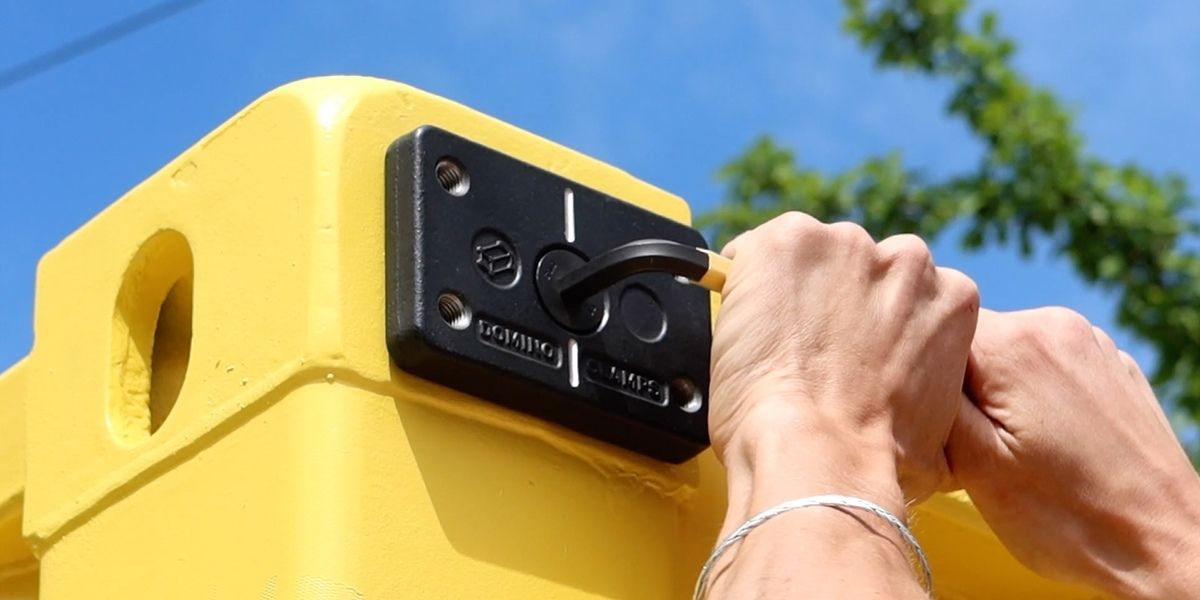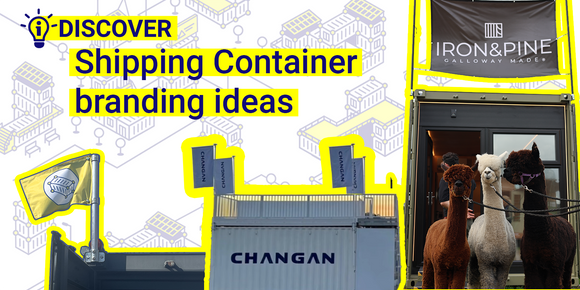
How to install and use Domino Clamps on a shipping container
3 comments
Although the explainer animation has been available to view for some time, we wanted to make a more comprehensive explanation of Domino Clamps.
In this blog post, we’ll go into more detail than we could in the video, with the added benefit of some explanatory images.
Parts of the Domino Clamp
The Domino Clamp consists of two main parts which have been drop-forged in the UK from EN3B grade steel. We refer to the larger of these as the front plate (or just the ‘Domino’) and the smaller piece which rotates behind as the clamping plate.
On the rear of the front plate is the boss; a stadium shaped lump of steel into which is set the ‘female’ half of the cam mechanism. The other ‘male’ half of the cam mechanism is on the clamping plate.
In the front face of the Domino are four M12 threaded holes. Once the Domino is clamped onto the container, one or more of these can be used to bolt other items to the container. The indented vertical line serves as a centre and vertical marker and will come into its own further down the line with certain bolt-on adapters. It also gives it its unique domino appearance.

Connecting the two steel halves is a custom, high-tensile 10.9 bolt which we refer to as the tightening bolt or the central bolt. This sits in a countersink machined into the front face of the Domino so that it sits flush and out of the way once it is done up, and is set with a 10mm hex socket for tightening and untightening the Domino into position in the corner casting. On the tail of the bolt is a serclip which prevents the bolt from being undone fully, and rotates the clamping plate back into an upright position for removal from the corner casting.
In terms of protection, the two main parts of the Domino Clamp are dual-protected; first, they are electroplated with zinc, then they are finished with a coat of black Xylan, for additional impact and corrosion resistance. Thanks to these coatings, your Domino Clamps should last you a very long time and many, many uses, as long as you take care of them.
Where does the Domino Clamp fit?
The Domino Clamp is designed to fit into either of the holes on the sides of all ISO standard shipping containers, and any other portable unit which uses ISO standard corner castings.

Most of these are the stadium shape variety, and on a shipping container can be found on all four corners of the long sides, and the lower two corners on the short sides (door and rear wall). A differently shaped hole is found on the upper corner castings on the shorter sides, and since this looks kind of like a shield, we refer to it as such.
|
DID YOU KNOW? In geometry, the stadium shape actually goes by two other names. The first is ‘obround’ and the other, our personal favourite which we don’t use because everyone thinks we made it up is “discorectangle” |
The holes found on the top face of the upper corner castings are larger than the ones on the underside of the lower corner castings And although the Domino will fit in these, it is not tested to do so. Therefore, we STRONGLY advise that you not to use Domino Clamps in these larger holes. We are looking into the possibility of making a new version which can be used here, or an adapter to make it safe to use our existing product in these holes. If you need something to clamp into these holes, please contact us.
Installing the Domino Clamp
We ship out Domino Clamps in the ‘clamped’ position, so you’ll need to undo it first. Using a 10mm hex key (allen key), undo the central bolt all the way until it won’t undo any further, at which point the serclip will meet the back of the clamping plate (don’t force it). If you maintain a bit of forward pressure on the bolt as you undo it, you will notice that the clamping plate rotates as you do this so that it is in an upright position, in alignment with the boss.

Now that the Domino Clamp is ready, it’s time to prep the casting. The aim here is to make sure you have a good, solid grip on the inside of the casting and that there is nothing to obstruct the rotation of the clamping plate. Castings are notoriously good spots for nesting birds and animals, so do check first and clear out any nesting materials inside. If possible, use a hard blunt instrument to scrape away any loose rust or debris from the inside surface that you are clamping to.
 |
Nobody wants to have to disturb an animal's nest, so our ingenious friends over at LiIftPoint pro actually have a product to plug the holes in the castings, which prevents birds and animals from nesting, so you don't have to take on the unpleasant task of evicting them.
|
Now you are ready to insert the Domino into the corner casting you need to attach to. Simply hold the Domino the correct way up and insert the clamping plate and the boss into the stadium/shield hole of the corner casting.
Next, let the weight of the clamp bring it down so it is resting on the lower lip of the hole, and do up the central bolt so it is nice and tight. We advise to do these up to about 35-40Nm, which you can either do precisely with a torque wrench or a long arm hex key. If you’re using a 10mm hex key, just do it up about as tight as you can by hand.

Attaching things to the Domino clamp
Now the clamp is ready to bolt on whatever you need. Check the Domino Clamp technical sheet for normal working loads, and be careful not to exceed these.
You’ll also see in the technical sheet that Domino Clamps aren’t to be used to lift a container. There are lots of products for lifting containers that already exist, and it’s not what Domino Clamps were designed for.
| An important note about high load scenarios. If you are approaching the clamp's maximum load capacity it is important to check the central bolt’s tightness before and after the load is applied. This check should be repeated when reapplying large loads to the same clamp. If you are unsure about the total load you’re applying, we recommend you employ the services of an engineer to assist you in this operation. |
There are a number of things which will bolt directly to the front of the Domino without the need for any kind of adaptor plate, some of which you will find in our shop and instructions in our "Uses" blog.
Of course, if there is anything you need to connect, but don’t know how, then please contact us - we’d be more than happy to try and find you a solution.
It is important not to use a bolt that is too long for the object you are attaching to it. If the bolt is too long, then instead of securing the object to the clamp, the bolt will go all the way through the clamp and hit the corner casting. This will mean that you will either not be able to firmly attach the object, or the bolt will exert undue stress on the Domino, pushing it away from the corner casting, or both. Add up the thickness of what you need to attach, plus 20mm for the domino, then find one bolt size down from that. Always try to have at least about 15mm of thread in the domino though. For example, if you are attaching a 24mm thick steel bracket to a domino clamp, using 2mm thick washers, that gives a total of 2mm + 24mm + 20mm = 46mm. With 45mm bolts, you'll have 1mm to spare and they'll be perfect for the job.

Undoing the Domino Clamp
To undo the Domino clamp, first make sure that it is no longer supporting any significant load that you can’t take the weight of one-handed. Then simply undo the central bolt as you did at the beginning. keep the central bolt in its countersink, and the clamping plate will rotate back into the upright position. You’ll be able to remove the clamp easily straight out of the hole.

Care for your Domino Clamp
As with any piece of rigging equipment, care should be taken with your Domino Clamps to keep them in good shape. Try not to bash them around and when undoing them, and don’t undo this bolt so much that it begins to bend the serclip.
The black Xylan finish on the Domino Clamps should maintain a smooth operation of the central bolt for years, but eventually this too may need some assistance. If you find the central bolt has become sticky after lots of use, a little lubricating oil will help.
With proper care, your Domino Clamps should last for many years and hundreds of uses.
Happy clamping!
For more ingenious container solutions, useful information and offers delivered direct to your inbox, sign up to our information email 📨 or subscribe to our YouTube channel 📺






Comments (3)
You can buy Domino Clamps here: https://dominoclamps.com/products/domino-clamp
where can you buy domino clamps and how much
Your product should be on Amazon, you would sell so many of these!